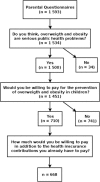Parents' willingness to pay for the prevention of childhood overweight and obesity
- PMID: 26208923
- PMCID: PMC4883987
- DOI: 10.1186/s13561-014-0020-8
Parents' willingness to pay for the prevention of childhood overweight and obesity
Abstract
Objective: To determine parental willingness-to-pay (WTP) for childhood obesity prevention.
Methods: Cross-sectional data from the follow-up measurements (2011) of a health promotion programme in German primary schools. Data collection included anthropometric measurements of children and self-administered questionnaires for parents, including WTP assessment. Mann-Whitney U-Test was used for differences between groups, and regression analysis to identify factors associated with general WTP and amount of WTP.
Results: From 1 534 parents, 97.8% considered overweight/obesity to be serious public health problems. A general WTP to reduce the incidence of childhood overweight/obesity by half, was declared by 48.8%. Parents of overweight/obese children showed with 61.4%, significantly more frequently, their general WTP than the others with 47.2% (p = 0.001). Mean WTP was <euro>23.04 (99% confidence interval (CI) [22.45; 23.75]) per month. Parents of centrally obese children showed significantly higher WTP than parents of the other children (p = 0.001). General WTP and the amount of WTP were associated with the central obesity of the child, migration status and household income. Additionally, general WTP was associated with maternal obesity.
Conclusions: Nearly half of the parents were willing to invest in prevention of obesity. The general WTP significantly occurs more often and with higher amount in affected parents.
Figures


References
-
- Rokholm B, Baker JL, Sorensen TI: The levelling off of the obesity epidemic since the year 1999-a review of evidence and perspectives. Obes Rev 2014, doi:10.1111/j.1467–789X.2010.00810.x. - PubMed
-
- Garnett SP, Baur LA, Cowell CT: The prevalence of increased central adiposity in Australian school children 1985 to 2007. Obes Rev 2011, doi:10.1111/j.1467–789X.2011.00899.x. - PubMed
-
- Janssen I, Shields M, Craig CL, Tremblay CS: Prevalence and secular changes in abdominal obesity in Canadian adolescents and adults, 1981 to 2007-2009. Obes Rev 2011, doi:10.1111/j.1467–789X.2010.00815.x. - PubMed
-
- Li C, Ford ES, Mokdad AH, Cook S: Recent trends in waist circumference and waist-height ratio among US children and adolescents. Pediatrics 2006, doi:10.1542/peds.2006–1062. - PubMed
-
- Janssen I, Katzmarzyk PT, Ross R. Waist circumference and not body mass index explains obesity-related health risk. Am J Clin Nutr. 2004;79:379–384. - PubMed
LinkOut - more resources
Full Text Sources
Other Literature Sources

